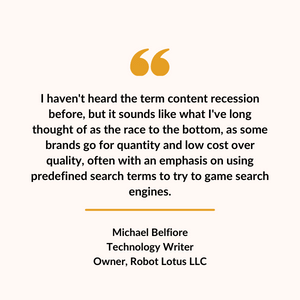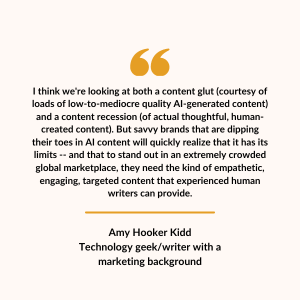What do you think? Are we facing a content recession? While the topic is debatable, it’s still worth discussing.
What is a Content Recession?
Unless you live in a vacuum, you’ve heard that agency copywriters are either being let go or having trouble finding work. While this isn’t happening to every writer across the board, scrolling through LinkedIn gives you a good idea of what’s happening.
 That makes us wonder – are we facing a content recession? Some think so, yes, but others aren’t quite sure. For example, when I asked Michael Belfiore about this, here’s how he responded:
That makes us wonder – are we facing a content recession? Some think so, yes, but others aren’t quite sure. For example, when I asked Michael Belfiore about this, here’s how he responded:
“I haven’t heard the term content recession before, but it sounds like what I’ve long thought of as the race to the bottom, as some brands go for quantity and low cost over quality, often with an emphasis on using predefined search terms to try to game search engines.” He continues, “ It makes sense that such brands would lean heavily on AI to generate more content. However, I haven’t seen brands that value quality over quantity changing their practices.”
So, before answering that question (or attempting to), let’s unpack what a content recession is:
A content recession is a period of economic decline in the content creation and marketing industry. It’s characterized by a decrease in demand for content as brands and marketers become more cautious with their spending. This can lead to layoffs, budget cuts, and a decline in the quality of content.
Potential Causes for a Content Recession
Okay, that seems pretty straightforward. Next question: What factors lead to a content recession?
Economic Factors
Economic recessions or other economic difficulties can impact the demand for content creation. If many companies face financial challenges, this might result in a content recession. When brands have less money to spend, they are less likely to spend it on content.
 Kara Detwiller shares her thoughts about that, “In my experience, even top writers are feeling the effects of the content recession, but there are still plenty of opportunities out there.”
Kara Detwiller shares her thoughts about that, “In my experience, even top writers are feeling the effects of the content recession, but there are still plenty of opportunities out there.”
She explains, “Although some companies are being more conservative with their content budgets, many are still investing in content, and many are looking for support from contractors and freelancers rather than full-time employees.”
A Decline In The Effectiveness of Content Marketing
Content marketing is an effective strategy to engage with your audience and drive customer acquisition. However, as consumers become more inundated with content, they develop ad-blindness and ad-avoidance techniques. I’m sure you’ve scrolled through social media, and even though there are dozens of ads in your feed, you probably don’t notice them very often.
Irrelevant or poorly targeted content is often ignored or blocked, reducing the effectiveness of content marketing efforts. Then, there’s the issue of attention spans:
“In 2004, we found the average attention span on any screen to be two and a half minutes on average. Throughout the years, it became shorter. So around 2012, we found it to be 75 seconds. And then in the last five or six years, we found it to average about 47 seconds,” explained Gloria Mark, Ph.D.
This shift in consumer behavior might discourage you or other brands from investing in content marketing, leading to a decrease in content creation.
Changing Content Consumption Habits
With almost everyone using mobile devices and on-the-go internet access, consumers have control over when and how they consume content. Short-form content, such as videos, memes, and social media posts, has gained popularity because they’re quick and easy to digest. This change in content consumption habits may affect traditional content formats, like long articles or white papers, potentially leading to a decline in readership.
Additionally, the demand for user-generated content has surged, empowering individuals to become content creators. This democratization of content creation could lead to a saturation of the market, making it harder for brands to stand out and find a sustainable audience. That could lead to the need to explore other strategies to retain engagement and stay relevant.
The Rise of New Technologies
 New technologies, like video streaming, have made it easier for consumers to find and consume content for free. The rise of AI technology has also played a key role. Here’s what Amy Hooker Kidd says about that:
New technologies, like video streaming, have made it easier for consumers to find and consume content for free. The rise of AI technology has also played a key role. Here’s what Amy Hooker Kidd says about that:
“I think we’re looking at both a content glut (courtesy of loads of low-to-mediocre quality AI-generated content) and a content recession (of actual thoughtful, human-created content). But savvy brands that are dipping their toes in AI content will quickly realize that it has its limits — and that to stand out in an extremely crowded global marketplace, they need the kind of empathetic, engaging, targeted content that experienced human writers can provide.”
She continues, “As writers, we can and should help our clients effectively navigate the use of AI, identifying where it can provide a head start or save time — while simultaneously ensuring the writing has the all-important human element and that the finished content accurately reflects the brand’s voice, values, and value proposition.”
Content Recession-Proofing Strategies
Whether we’re facing a content recession or not, having some strategies to combat it is a good idea. As the saying goes -“It’s better to have it and not need it than to need it and not have it.”
Focus on Bottom-Funnel Content
Prioritize content that directly drives conversions, whether sales, leads, or sign-ups. By creating compelling bottom-funnel content, you can guide potential customers through the decision-making process, nudging them closer to making a purchase or taking a specific action. This content should highlight the value and benefits of products or services, address customer pain points, and provide strong calls to action.
Repurpose Existing Content
Creating new content from scratch can be resource-intensive. That’s bad news if you’re facing budget cuts. However, it’s still possible to get something “new” by looking through your existing content. Here are some suggestions:
- Take data from an article or blog post and use it for an infographic
- Pull quotes from case studies and other assets and turn them into social media posts
- Look for opportunities to update out-of-date assets
- Create blog posts based on webinars, white papers, and other long-form content
Use Data-Driven Marketing
Data-driven marketing is a powerful approach that involves analyzing and leveraging data to make informed decisions about content marketing campaigns. For example, you can use this data to:
- Monitor content performance metrics
- Track customer behavior
- Identify trends
By understanding what content resonates most with your audience, it’s possible to optimize marketing efforts, focus on high-impact initiatives, and allocate resources more efficiently.
Partner With Influencers
Influencer marketing can be a game-changer in expanding your content’s reach. Collaborating with influencers in your industry allows you to tap into their dedicated following and gain exposure to new audiences. Influencers can create authentic, engaging content that:
- Aligns with your brand values
- Increases brand awareness
- Fosters trust among potential customers
Invest in Evergreen Content
Evergreen content refers to assets that remain relevant and valuable over extended periods. Creating this type of content continues attracting organic traffic and is a long-term asset. Furthermore, it typically addresses timeless topics, provides educational value, and solves common problems.
nDash: The Content Recession-Proofing Solution
Whether we’re facing a content recession or not, our content creation platform can help you create and distribute content that engages your audience and drives results. Contact us today to learn how our content services can help you save time and receive the highest quality content.

